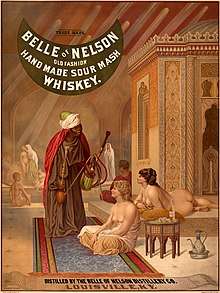Sour mash

Sour mash is a process used in the distilling industry that uses material from an older batch of mash to start the fermentation of a new batch, analogous to the making of sourdough bread with a starter. The term sour mash can also be used as the name of the type of mash used in that process, and a Bourbon made using this process can be referred to as a sour mash Bourbon. Sour mash does not refer to the flavor of the Bourbon, as is sometimes thought.
In the sour mash process, the mash – a mixture of grain, malt and water – is conditioned with some amount of spent mash (previously fermented mash that still contains live yeast). Spent mash is also known as spent beer, distillers' spent grain, stillage, and slop or feed mash, so named because it is used as animal feed. The acid introduced by using the sour mash controls the growth of bacteria that could taint the Bourbon and creates a proper pH balance for the yeast to work. An established and active strain of live yeast is introduced into the mash that is to be fermented. By using an established and known fermented "sour", this fermentation process controls the introduction and growth of foreign bacteria and yeasts that could damage the Bourbon, and improves the consistency and quality of the liquor, so that every bottle tastes as close to the same as possible.
Sour mashing is also a process sometimes used in brewing to make sour beers without the typical year or more timeframe. In the brewing version of sour mashing, brewers mash in their grains to begin the brewing process but instead of extracting the wort from the grains at the end of the mash (typically under ninety minutes), the brewer will leave the grains and wort together for as long as several days before draining the wort. During this time, the lactic acid bacteria naturally present on the grain will ferment some of the sugars in the wort into lactic acid. This lactic acid will add sourness to the beer. In order to promote fast bacterial fermentation, the mash is kept between 100–120 °F (38–49 °C). The brewer will extract the wort by sparging when they believe enough acid has been produced. Some beers employing sour mashing will be fermented with the addition of brewing yeast but without a boil. Other brewers prefer to boil their sour mashed beer and then ferment it with brewing yeast. The resulting beers can range from mildly tart to noticeably sour, but usually are not as sour as beers intentionally soured after primary fermentation is complete.
See also
References
https://alcohol.stackexchange.com/questions/5015/difference-between-whiskey-and-bourbon